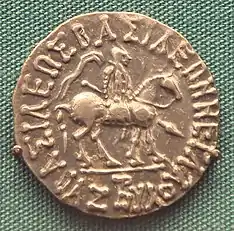(47 BCE)
The "Azes era" (also known as the Aja or Ajasa era, Prakrit: Ayasa vaṣaye)[1] starting 47/46 BCE,[2] was named after the Indo-Scythian king, "King Azes the Great" or Azes I. As a number of inscriptions are dated in this era it is of great importance in dating the reigns of several kings and events in early Indian history.
Earlier, some scholars believed that the Azes era was same as the Vikrama Samvat (57 BCE) used in the Indian subcontinent. However, this was disputed by Robert Bracey following discovery of an inscription of Vijayamitra, which is dated in two eras.[3] Research by Falk and Bennett (2009) shows that these two were indeed separate eras, and that the Azes era can be dated with a high degree of likelihood to 47 BCE, or c. 48/47 or 47/46 BCE, depending on whether it began in the spring or the autumn.[4][2]
It is now thought that the Azes era was probably created by Azes as a continuation of the Arsacid era which started in 247 BCE and marked the foundation of the Parthian Empire,[5] year 1 of Azes corresponding exactly to year 201 of the Arsacid era.[2]
The Azes era was recently connected to the Yavana era thanks to the Rukhana reliquary inscription.
Footnotes
- ↑ "Silk Road Art and Archaeology". Journal of the Institute of Silk Road Studies, Kamakura. The Institute. 9: 49. 2003.
- 1 2 3 Falk, Harry (2007). "Ancient Indian Eras: An Overview". Bulletin of the Asia Institute. 21: 136. JSTOR 24049367.
- ↑ Alf Hiltebeitel (2011). Reading the Fifth Veda: Studies on the Mahābhārata. BRILL. p. 103. ISBN 978-90-04-18566-1.
- ↑ Falk and Bennett (2009), pp. 197-215.
- ↑ "The "Arsacid" era – Encyclopaedia Iranica". www.iranicaonline.org. Encyclopedia Iranica.
References
- Harry Falk and Chris Bennett (2009). "Macedonian Intercalary Months and the Era of Azes". Acta Orientalia (70): 197–215. ISSN 0001-6438. Retrieved 11 April 2014.
- Senior, R. C, (2008). "The Final Nail in the Coffin of Azes II." Journal of the Oriental Numismatic Society 197 (2008), pp. 25–27.
